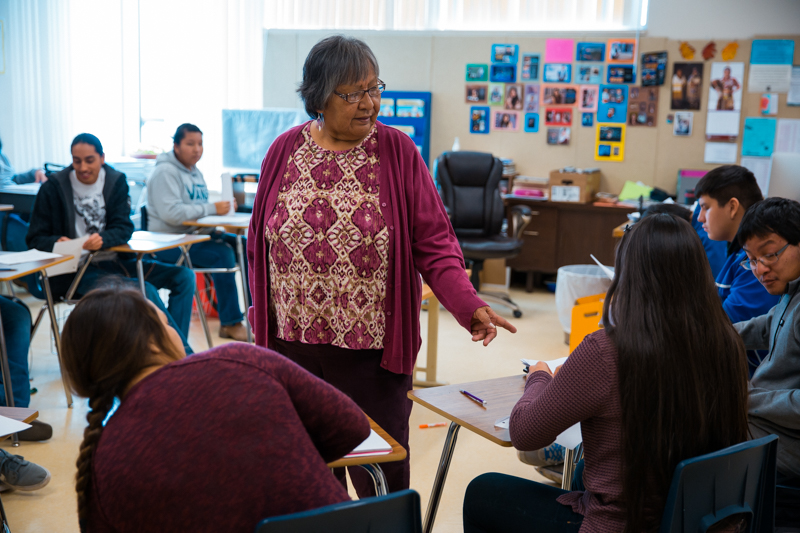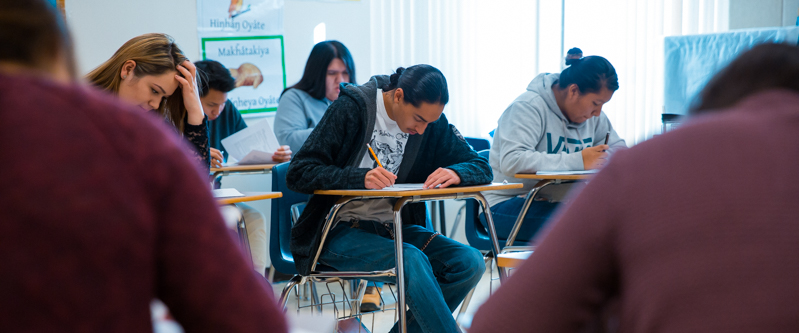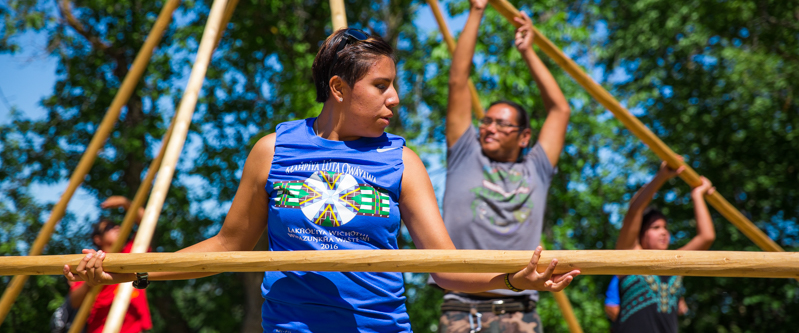Phase II of the Lakota Language Project Cultivates More Ways of Accessing the Lakota Language in the Classroom and across the Community
posted December 20, 2016

Recently, a fourth grade teacher at Red Cloud Indian School asked a group of her students to reflect on what it means to be able to learn Lakota, the language of their ancestors. One by one, they answered with excitement and deep pride in their voices. They spoke about how much they wanted to save the language by learning how to speak, read, and write, and by sharing the language with those who have never had the chance to hear it. They talked about joining language competitions and practicing at home with their families in order to become better speakers. And one youngster—Abigail—shared she is already becoming a Lakota teacher herself.
“Me and my sister are teaching my brother, who is only two, to speak in Lakota,” she explained. “He’s already saying ‘Malákȟota,’ which means ‘I am Lakota.’ We are saving the language by learning more Lakota.”
There are students like Abigail in every classroom at Red Cloud—students whose excitement for language learning grows every day. That excitement is the result of nearly a decade of work by Red Cloud’s groundbreaking Lakota Language Project (LLP). The LLP was created to support a new generation of fluent Lakota speakers—and to reconnect students with their history and cultural identity. And while it is already accomplishing its goals, the Red Cloud community has no intention of slowing down: in 2015, LLP teachers, administrators, and staff launched the LLP’s second phase focused on bringing language learning out of the classroom and into the community.
Having taught Lakota language in the classroom for decades, Red Cloud was ready to implement its newly-developed instructional levels of the LLP in 2008, when fifth, sixth, and ninth graders began learning a revitalized Lakota curriculum as part of their daily studies. In the years to follow, the program expanded to include more grade levels. By 2015, Red Cloud students of all ages were learning from an updated curriculum and the first phase of the project was completed. The LLP became the nation’s first comprehensive K-12 Lakota language curriculum, with the goal of helping Red Cloud students become proficient in their native language by the time they graduated. The LLP was designed to create a new generation of fluent Lakota speakers—and to reconnect students with their history and cultural identity.
Today Red Cloud continues building on the success of the LLP’s first phase, creating more dynamic language learning opportunities for students, staff, families, and members of the extended community. According to Robert Brave Heart Sr., Red Cloud’s executive vice president and the director of the LLP, the second phase of the LLP is focused on expanding access to Lakota literature, strengthening teachers’ skills through professional development, and increasing the ways Lakota is used on campus and across the reservation.
“Through the first phase of the Lakota Language Project, we worked to create a curriculum that would follow our students from kindergarten through high school and support them in reconnecting with the language in our classrooms,” said Brave Heart. “Now we are advancing that work to the next level by creating more sophisticated resources and opportunities to serve both our students and the larger community. Today you can hear Lakota being spoken across the reservation and for me that signals a true revitalization of our language.”

New Readers Bring Lakota Stories to Life
In this second phase of the LLP, administrators are tackling one of the most critical challenges in teaching the Lakota language: the lack of available books for students to practice reading in Lakota. Red Cloud created its own textbooks for the curriculum during the first phase of the project, but students rarely had access to other Lakota books.
This winter, however, Red Cloud students will have the chance to discover new stories—written entirely in Lakota. The LLP team began creating its first storybooks earlier this year, working in close collaboration with Christine Lajtay, a fluent Lakota speaker, to ensure cultural and linguistic accuracy, as well as with Lakota illustrator Cecil Apple, Sr., who has worked with the Project since its early years. The final edits were incorporated into the first two volumes of readers—designed for beginner Lakota students—earlier this fall. And soon they will be in classrooms as a new resource for both teachers and students.
“Learning a new language without access to books is extremely difficult, so last year we decided we had to create something that would work for us and support our unique curriculum,” said Melissa Strickland, the LLP’s program coordinator. “These beginning readers will give our students the ability to deepen their language skills while reading stories that relate to their own cultural and heritage. We’re so excited to get these readers into the classrooms—and we’re already working on the next books so that students at all levels will benefit.”
Another three volumes of readers are currently being written and illustrated for students with intermediate skills, and Strickland plans to have them in classrooms in the late spring or early next fall. Program staff are also updating and editing stories published by Red Cloud in the 1960’s and 1970’s, which will serve as the content for the advanced level readers set for production in the 2017-2018 academic year.
More Professional Development Engages and Inspires Language Teachers
In addition to new reading materials, this second phase of the LLP is helping Lakota language teachers and non-language teachers alike gain new skills through targeted professional development opportunities. Just before school kicked off this year, Strickland led several mini-workshops with new volunteers to introduce them to the LLP, the orthography, and words and phrases used in the classroom. She also worked with Lakota language teachers during a two-day seminar to discuss and plan for the 2017 Lakota Language Summer Camp, as well as to address best practices in lesson planning, setting clear objectives, and designing language learning exercises that will engage and inspire students. In October, the language teachers took part in an in-depth Lakota language workshop taught by second language learning expert Jim MacDiarmid, as well as an inservice day led by staff member Tama I’atala that expanded on methods for lesson planning and successful language instruction.
Professional development is happening beyond Red Cloud’s campus as well. This fall Lakota language teachers joined with community members in attending the 2016 Lakota Dakota Nakota Language Summit in Rapid City. The gathering brought together leaders from over 20 tribes across the Oceti Sakowin (or Great Sioux Nation) who are working toward language revitalization. During the summit, Red Cloud teachers were able to engage with other educators, learners and advocates, and share strategies, methods and resources that are being used to create new generations of Native language speakers. For teachers like Randi Gibbons, who teaches in Red Cloud’s middle school, it was a powerful experience that not only provided useful instruction—but also reminded her of how critical teaching Lakota really is.
“The Tusweca conference...helped to clarify some different topics that I had questions about. And it was good to hear from some of the influential Lakota speakers that we have,” said Gibbons. “It is so important that we are teaching the language because we have so few speakers amongst us. When I was growing up, my mother didn't speak Lakota, but she understood it. I would hear my elders speak and I wanted to be like them. I wish we had a program like we do now back then, because it is giving students the tools to become speakers.”

Taking Language Beyond the Classroom and into the Community
As a result of the LLP, Lakota is spoken, written, and read inside Red Cloud’s classrooms each and every school day. But administrators say what is most exciting now is witnessing Lakota being used outside the classroom and in the community. This summer, during Red Cloud’s third annual Lakota Language Summer Camp, over 80 people came together for an evening meal and dance to learn together. Students of all ages, parents and relatives, and community members from across the reservation spent the evening celebrating language as an essential element of Lakota culture. For Strickland and other program leaders, it emphasized how deeply committed the entire community is to Lakota language revitalization.
During this second phase of the LLP, program staff are creating even more opportunities for speaking Lakota in daily life. Tama I’atala, the LLP’s new Activities Coordinator, has only been in his role for a few short months, but he is already bringing the language into more places on campus. Already, he has helped to create several booths at Red Cloud’s annual Halloween Carnival using only the Lakota language. In the middle school, he has introduced a phrase-of-the-day initiative to get students speaking the language on a daily basis. And he worked alongside the high school students who led November’s traditional buffalo harvest on campus to integrate language speaking throughout the process.
Tama brings a deep knowledge of Lakota language education to Red Cloud. He completed the Lakota Language Education Action Program (LLEAP) through the University of South Dakota and has taught language to students from kindergarten through college, and to adult learners as well. Looking forward, Tama is preparing to draw on his experience to create more innovative learning opportunities that engage not only students, but also families and community members.
“I am so excited to be a part of the LLP team because of the passion I have for sharing the language. We are looking to start a second language learners class, a middle school mentoring program utilizing existing partnerships with local community organizations, and overall trying to get as much Lakota language out into community,” said Tama
“I am a strong believer that the cornerstone of culture and spirituality is language…[and] it is incredibly inspiring to hear the use of Lakota outside the classroom. After generations of cultural loss it signifies a healing—a hope. Getting our youth invested in the language is going to secure a strong future for our culture and spirituality as Lakota people.”
In addition to Tama’s work, Red Cloud teachers are providing parents with language learning materials so that they can practice speaking Lakota at home with their children. Moreover, program staff maintain project web pages that allow parents and community members to access resources related to learning Lakota. The school has also developed a strong partnership with Thunder Valley Community Development Corporation’s language initiative, which offers instructional sessions for adult language learners across the reservation.
According to LLP program staff, it is the family language nights launched last year that truly highlight the community’s commitment to language learning. These evening events—hosted on Red Cloud’s campus—bring families together to learn new words and phrases, participate in cultural activities, and share a community meal. The response has been overwhelmingly positive: since they began, over 125 students, parents and relatives have attended a family language night to learn together.
Today, many Red Cloud parents say that their students are more and more frequently speaking Lakota at home, and encouraging their families to do the same. For Randi Gibbons, that will ultimately be a real legacy of the LLP.
“It is good to hear students using the language outside of the classroom, and it makes your heart happy knowing that you had some part of that,” said Gibbons. “If you just start with a few phrases here and there, kids will pick up on it. We need more speakers to speak Lakota because when we have our language, we have the power to do anything. Culture and language coincide, so you can't have one without the other and, knowing that these students are in the process of learning is powerful.”
READ MORE!
Photos © Red Cloud Indian School